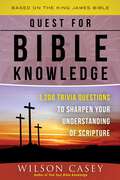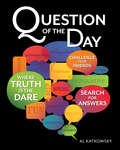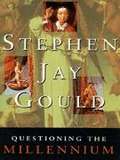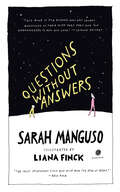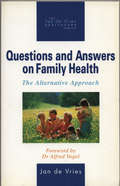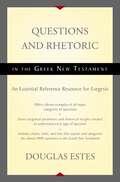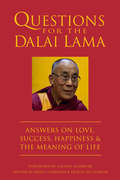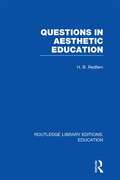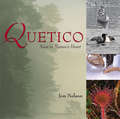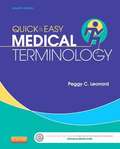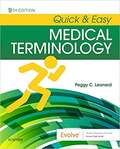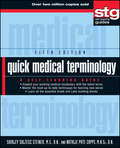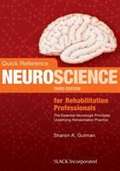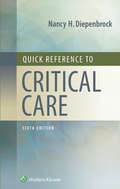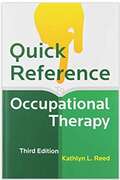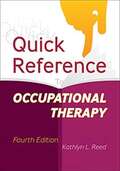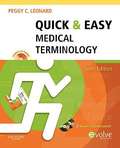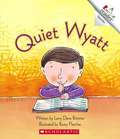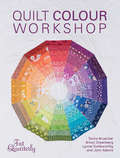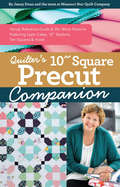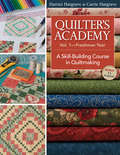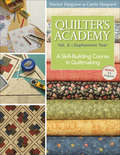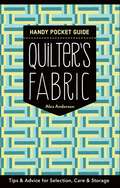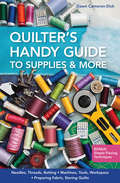- Table View
- List View
Quest for Bible Knowledge: 1,206 Trivia Questions to Sharpen Your Understanding of Scripture
by Wilson CaseyPut your Bible knowledge to the test with 1,206 brand-new biblical trivia questions guaranteed to keep you praising the Lord every day of the week. People are passionate when it comes to the Lord&’s word, as the Holy Bible has remained in the top-most rank of bestselling books of all time. Quest for Bible Knowledge (a follow-up to Test Your Bible Knowledge) is a fun, informative, and entertaining way to see how well you know the Good Book. Trivia expert and author Wilson Casey has compiled 1,206 fascinating questions about the people, history, stories, and facts from the Bible. Each page is a separate quiz with six enlightening and fresh questions with multiple-choice answers. In addition, every correct answer includes references to the relevant chapter and verse in scripture for further study and clarification. It&’s the perfect companion for the multitudes wanting to test their biblical knowledge (and keep score if desired). The quizzes cover the entire scope of the Holy Bible, exclusively based on the beloved King James Version. Readers may play as many of the quizzes as desired per sitting, and can skip around or complete them in order. And for easy lookup and reference, there&’s a thorough index at the book&’s end. Whatever your age, Quest for Bible Knowledge guarantees hours of enlightening fun.
Question of the Day: Where Truth is the Dare
by Al KatkowskyPerfect for spending time with friends, family or even co-workers, Question of the Day is designed to help people explore a variety of topics that challenge them to think, be brutally honest, and form perhaps previously unstated opinions. Using these questions is fun, enlightening, surprising and revealing'ideal as an ice breaker among willing acquaintances or as a source of deeper conversation among old friends. It's fun, but also challenging and the subtitle is meant to reflect that. Questions are ranked on a scale from 'light' to 'heavy' indicating the introspection, honesty, and even deep thinking required by the individuals the question is posed to. The questions can incite funny answers, embarrassment'even an unwillingness to answer. But every reaction to a question reveals to the group insights into the beliefs of the people answering. "Question of the Dayreads and plays like a game. The result is a much more stimulating version of The Book of Questions. ' -- Glenn Taverna, general manager, Border Books and Music Westbury, NY
Questioning the Millennium: A Rationalist's Guide to a Precisely Arbitrary Countdown
by Stephen Jay GouldIn this new edition of Questioning the Millennium, best-selling author Stephen Jay Gould applies his wit and erudition to one of today's most pressing subjects: the significance of the millennium.
Questions Without Answers
by Sarah MangusoPondering the questions only kids would think to ask, this hilarious, poignant collection captures the wonder of a child&’s imagination, brought to life by beloved New Yorker cartoonist Liana Finck.&“This book is for anyone who has secret questions in their mind they are too embarrassed to ask out loud. In other words, this book is for everyone.&”—Lemony Snicket, bestselling author of A Series of Unfortunate Events and All the Wrong QuestionsWhy does a ghost wander? Are bubbles in drinks their thoughts? Do dogs have chins? Where does the dark go when the light comes on? How will it feel on the last day I&’m a child?What&’s the best question a kid ever asked you? When Sarah Manguso opened a Twitter account and posted this single (and only) tweet, she immediately received hundreds of answers. Many, she discovered, were intelligent, intuitive, inventive, and philosophical. For Manguso, these responses seemed to form a &“choral philosophy&” that she believes disappears from most people&’s lives in kindergarten. As she says in her illuminating foreword, &“These questions are cute by the word&’s original definition, swift and piercing. They cut to the quick.&”Gathering more than one hundred of the best questions from this poll and bringing them brilliantly to life with illustrations by New Yorker cartoonist Liana Finck, Questions Without Answers ranges from the ridiculous to the sublime—encompassing birth, death, poop, dinosaurs, and everything in between—to show us the wit and wisdom of little people in all their wondrous glory.
Questions and Answers on Family Health: The Alternative Approach
by Jan de VriesThis is the handbook for every household and is published in direct response to public demand. In this volume Jan de Vries uses all of his vast wealth of experience to answer hundreds of questions which have consistently been asked of him over the years, from varicose veins to the use of vitamin E, headaches to verrucae, from air and water pollution to ME, candida and other present-day problems. The foreword to this invaluable, easy-to-use reference guide is by Dr Alfred Vogel, author of the million-selling Nature Doctor and himself mentor to Jan de Vries.
Questions and Rhetoric in the Greek New Testament: An Essential Reference Resource for Exegesis
by Douglas EstesWhile there are almost 1000 questions in the Greek New Testament, many commentators, pastors, and students skip over the questions for more ‘theological’ verses or worse they convert questions into statements to mine them for what they are saying theologically. However, this is not the way questions in the Greek New Testament work, and it overlooks the rhetorical importance of questions and how they were used in the ancient world. Questions and Rhetoric in the Greek New Testament is a helpful and thorough examination of questions in the Greek New Testament, seen from the standpoint of grammatical, semantic, and linguistic analysis, with special emphasis on their rhetorical effects. It includes charts, tools, and lists that explain and categorize the almost 1000 questions in the Greek New Testament. Thus, the user is able to go to the section in the book dealing with the type of question they are studying and find the exegetical parameters needed to understand that question. Questions and Rhetoric in the Greek New Testament offers vibrant examples of all the major categories of questions to aid the reader in grasping how questions work in the Greek New Testament. Special emphasis is given to the way questions persuade and influence readers of the Greek New Testament.
Questions for the Dalai Lama
by Dalai Lama Dede Cummings Travis Hellstrom Lauren AlderferFor centuries, millions upon millions of people have sought out the wisdom of the Dalai Lama. Tenzin Gyatso, the current and XIV Dalai Lama, has traveled the world, spreading his personal doctrine of compassion and understanding. His sage words resonate with all who hear him speak, encompassing topics as grand as world peace, and as simple as learning to love ourselves. Presented in a clear, elegant format, Questions for the Dalai Lama poses universal questions, giving answers from the Dalai Lama himself, assembled from quotes, articles, speeches, and written works directly attributed to His Holiness. Organized into several themes, Questions for the Dalai Lama touches on themes ranging from love, to tragedy, to compassion and happiness. Drawing on the enduring words of the His Holiness, this inspirational book makes a wonderful gift for anyone seeking greater personal happiness and a life informed by compassion and wisdom. Organized into sections and built around a simple, informal question and answer format, Questions for the Dalai Lama is easy to understand, and easy to share with friends and loved ones. "The more you are motivated by love, the more fearless and free your actions will be." --XIV Dalai Lama
Questions in Aesthetic Education (Routledge Library Editions: Education)
by H B RedfernThe Question of what ‘aesthetic education’ is, or might be, is often a source of incomprehension. This book opens up discussion of a complex, difficult, but highly important topic, and offers an introductory survey of the whole area. In examining the relationship of the concept of the aesthetic to that of art, it challenges the persistent linking by many educationists of ‘aesthetic’ with ‘creative’ and the consequent neglect of critical reflection and appreciation.
Quetico: Near to Nature's Heart
by Jon NelsonQuetico Park in northwestern Ontario celebrates its 100th anniversary in 2009. Long-recognized as a gem among parks, Quetico contains some of the largest stands of old-growth red and white pine in Canada , as well as a diversity of fascinating lichens, carnivorous plants in specialized habitats. The author presents an insightful look into Quetico’s natural history as he examines the adapations that have allowed moose, white-tailed deer, wolves and other mammals to survive. The human history of the park is also explored, beginning with the Objiwa living there when the area was designated as a park, followed by accounts of trappers, loggers, miners, park rangers, and poachers. Beginning with the retreat of the glaciers, the author combines his thorough research into Quetico’s long and varied history with the threads of his own extensive involvement with the park. The result is a splendid tribute to a very special place.
Quick & Easy Medical Terminology (7th Edition)
by Peggy C. LeonardMake learning medical terminology faster and more fun with Quick & Easy Medical Terminology, 7th Edition Presenting terms in the context of body systems, this book helps you begin reading, writing, and speaking medical terms in the shortest time possible. Small chunks of information are always followed immediately by exercises, so you will be learning every minute This edition adds oodles of many new illustrations and a new "Special Senses" chapter, and an Evolve companion website includes word games, activities, and audio pronunciations to make it easier to understand and remember terminology. Written in a clear, conversational style by Peggy C. Leonard, this resource gives you the tools to communicate effectively in the health care environment.
Quick And Easy Medical Terminology
by Peggy C. LeonardLearn to read, write, and speak in medical terms in no time! Ideal for one-semester courses and self-study, Quick & Easy Medical Terminology, 9th Edition covers disorders, diagnosis, and treatment with a strong focus on anatomy. This clear, concise text presents small bits of information followed immediately by a test for comprehension using a combination of programmed and traditional review questions. The ninth edition includes new medical reports with review exercises that are similar to those seen in the clinical setting, plus help from the companion Evolve site, Quick & Easy Medical Terminology gives you simple tools for good communication in the health care environment.
Quick Medical Terminology: A Self-teaching Guide (Wiley Self-teaching Guides #197)
by Shirley Soltesz Steiner Natalie Pate CappsThe new, updated edition of the classic medical terminology reference with over 200,000 copies sold Quick Medical Terminology has long been relied on by students and medical professionals looking to build or update their medical vocabulary. <P><P>This new fifth edition provides the tools and information needed to understand the simple logic behind hundreds of seemingly incomprehensible words, along with fresh exercises and current examples. Features new review exercises and self-tests, more than 250 new terms, medical measurements, and up-to-date examples Provides the tools necessary for building and sustaining a large working repertoire of medical terms The reference of choice for health practitioners and others who need to expand, improve, or refresh their medical vocabularies Filled with essential information presented in a clear and easy-to-follow format, Quick Medical Terminology is an invaluable learning tool and reference source.
Quick Reference Neuroscience for Rehabilitation Professionals: The Essential Neurologic Principles Underlying Rehabilitation Practice
by Sharon A. GutmanA concise and quick reference for the practitioner and student who are learning or reviewing the most relevant neuroscience principles supporting rehabilitation therapy. The updated third edition continues to meet a need in the rehabilitation profession that has gone unfilled - the ability to break down neuroscience information into the essential principles that can be used to understand neurological conditions and the principles underlying rehabilitation evaluation and practice. This fully-updated third edition provides a quick review of specific neuroscience concepts and principles that support rehabilitation interventions. In this era of information overload, this text rapidly and thoroughly provides condensed information in a user-friendly, easy-to-use format for readers to review and convey relevant information to patients. Sharon Gutman has organised the text into three parts: the first addresses neuroanatomy; the second addresses the function of neurological systems underlying physical, psychiatric, cognitive, and visual perceptual disorders; and the final section addresses clinical neuropathology related to ageing, addiction, memory, and the neurological substrates of sex and gender. A specific section describes the common neurodiagnostic tests that therapists do not administer but must have knowledge of when results are discussed at treatment team meetings. Features of the third edition: Presented in a simple and organised bulleted format. Large-scale colour illustrations to easily visualise neuroanatomical structures and systems. Text boxes to apply key neuroscience concepts to the understanding of common neurological disorders and treatment. Updated clinical test questions and glossary. The third edition bridges a gap by quickly providing the rehabilitation professional with the most salient information needed to understand neurologic principles underlying rehabilitation practice.
Quick Reference to Critical Care
by Nancy H. DiepenbrockThis indispensable pocket guide addresses a broad range of critical care patient topics, divided by body system and organized alphabetically within each chapter for quick access. Disease processes, disorders, medications, and titration, tests, lab results, formulas, ICU equipment and treatment strategies and goals are discussed. Each well-illustrated entry explains the latest evidence-based procedures and stabilization practices in a convenient, quick-read outline, making it the ideal quick reference for following proven protocols.
Quick Reference to Occupational Therapy
by Kathlyn L. ReedThis greatly enhanced and expanded Third Edition of Quick Reference to Occupational Therapy adds sixty-five topics and disorders to the already extensive list. All information in the text is updated. New and veteran therapists will benefit from having the latest disorder-specific information at their fingertips as they assess and treat clients. An extensive References for Further Reading section includes a review of the levels of evidence for each journal article. <p><p>Contents include: Developmental Disorders Sensory Disorders, Nervous System Disorders, Cardiopulmonary Disorders, Hand and Wrist Conditions, Injuries, Musculoskeletal Disorders, Systemic Disorders, Immunologic and Infectious Diseases, Skin Disorders, Cognitive-Perceptual Disorders, and Mental Disorders Lifestyle Disorders,
Quick Reference to Occupational Therapy
by Kathlyn L. ReedNow in the fourth edition, Quick Reference to Occupational Therapy provides a thoroughly updated reference to 158 diagnoses pertinent to occupational therapy. The diagnoses, organized by category, are accompanied by a succinct overview that includes description, cause, evaluation/assessment, problems/issues, intervention/treatment, precautions/safety considerations, and prognosis and outcome. These topics constitute an outline of information based on the Occupational Therapy Practice Frameworks III and IV. The 158 diagnoses covered in this remarkable text fall into 13 categories, and the book is divided into 14 sections to make it easy to navigate. The final section covers diagnoses with limited available literature. Sections: Developmental Disorders Sensory Disorders Nervous System Disorders Cardiopulmonary Disorders Hand and Wrist Conditions Injuries Musculoskeletal Disorders Systemic Disorders Immunologic and Infection Diseases Skin Disorders Cognitive-Perceptual Disorders Mental and Behavioral Disorders Lifestyle Conditions Single- or Two-Article Disorders
Quick and Easy Medical Terminology (6th Edition)
by Peggy C. LeonardMake learning medical terminology faster and more fun with Quick & Easy Medical Terminology, 6th Edition! Featuring CDs with interactive games and audio pronunciations, this book helps you begin reading, writing, and speaking medical terms in the shortest time possible. Small chunks of information are always followed immediately by exercises, so students will be learning "every minute!" The many puzzles, activities, and games make it easier to understand and remember terminology. Written in a clear, conversational style by Peggy C. Leonard, MT, MEd, this book gives you the tools to communicate effectively in the health care environment. A companion CD reinforces learning with fun, interactive exercises, including medical reports and Hear It/Spell It exercises. Two audio CDs let you listen to correct pronunciations of medical terms and encourage you to pronounce each term aloud. A flexible, body systems organization lets you go through the material in any order after completing the orientation chapters, making it easy to coordinate your study with other courses such as anatomy and physiology. The programmed learning approach presents content in small blocks called 'frames' that allow you to learn the content and get immediate feedback on your progress before proceeding. Diverse learning styles are accommodated by a wide variety of exercises -- labeling diagrams, writing terms, choosing pronunciation accents, recognizing misspelled terms, matching word parts, interpreting terms within health reports, and categorizing terms. Unique! A conversational writing style makes the book more readable and enjoyable. Unique! Thorough explanations of terms help you understand and remember the material by presenting terminology in a medical context. A consistent format to body systems chapters uses categories to simplify the learning of terms, with each chapter including function; structure; diseases, disorders, and diagnostic terms; and surgical and therapeutic interventions. Healthcare reports and case studies allow you to apply your knowledge to real-life situations. A review of anatomy and physiology at the beginning of each body systems chapter provides a context for understanding the medical terminology. Drug information is integrated into the body systems chapters, with detailed information on specific drugs on CD. Caution boxes alert you to confusing terms. Spanish translations of key terms are listed in each chapter to help you communicate with Hispanic patients; glossaries are included in the appendix. Comprehensive end-of-chapter reviews correspond to the learning objectives at the beginning of the chapter. A bookmark includes a quick-reference guide to pronouncing terms plus a list of pronunciation symbols. A companion Evolve website includes study tips, electronic flashcards, Body Spectrum coloring pages, an English/Spanish glossary, learning activities that include Spanish term exercises, updates, and links to related sites. More short exercises include Find the Clue and Connections puzzles, letting you check your learning more often and stay on track. Procedures and terminology updates keep you current with new technologies and terms you'll encounter in the workplace. Quick Tips in the margins add essential information and interesting, fun facts. Games add fun and competition to exercises on the companion CD. More medical reports with exercises are included on the CD, allowing you to use terms in real-life situations.
Quiet LOUD
by Leslie PatricelliThis is a book about synonyms and antonyms. "Crayons are quiet. Pots and pans are LOUD. BOOM BAM ..."
Quiet Wyatt
by Larry Dane BrimnerA boy who is normally very loud is quiet on this day. He imagines all the way he could be loud.
Quilt Colour Workshop
by John Adams Brioni Greenberg Tacha Bruecher Lynne GoldsworthyWhat makes a brilliant color combination? An inspiring, idea-filled guide to color theory and how to use it in your quilting projects!This useful guide shares the secrets of successfully using color in your quilting. Discover more about color theory and how to use it in the context of quilting, then apply this theory to practical projects, from quilts and cushions, to wall hangings, table runners and bags. Featuring six color-themed sections with block ideas for every color theory combination, it offers plenty of inspiration for you to create colorful projects!Contributing members of the quilting and sewing e-zine team at Fat Quarterly include Brioni Greenberg, John Adams, Tacha Bruecher and Lynne Goldsworthy.
Quilter's 10" Square Precut Companion: Handy Reference Guide & 20+ Block Patterns
by Jenny DoanEverything you need to know about making quilts with 10-inch square precuts.Master 10&” square precuts with this complete and indispensable guide! Sew 20+ traditional blocks with timesaving tips and tricks from the one and only Missouri Star Quilt Company. You&’ll cover all the basics, including easy half-square triangle construction, cutting other shapes from 10&” squares, and guidelines of how many 10&” square packs are needed for different size quilts. Easy-to-use illustrations are at your fingertips in this useful, information-packed reference.
Quilter's Academy Vol 1–Freshman Year: A Skill-building Course In Quiltmaking (Quilter's Academy)
by Harriet Hargrave Carrie HargraveThis comprehensive beginner&’s guide to quilting skills covers everything from setting up a sewing area to designing your own quilts. Harriet Hargrave has taught quilting all over the world. Now, with the Quilter&’s Academy series of coursebooks, you can learn from her mastery and decades of experience. Volume one of the series welcomes freshman quilters with classes, lessons, exercises, and projects that will build your skills from one project to the next. Arranged in order of complexity, each quilt offers new challenges and involves new techniques that will help you continually build your skill level. By mastering the techniques presented in Quilter&’s Academy Vol. 1, you will be on your way to creating your own quilts with precise, high-quality piecing. Includes compete instructions for making 13 classic quilts!
Quilter's Academy, Volume 2—Sophomore Year: A Skill-Building Course in Quiltmaking (Quilter's Academy #2)
by Harriet Hargrave Carrie HargraveGet a college-level education in quiltmaking in the comfort of your home with the second in the classic series—plus eleven projects to practice your skills! From the mother-daughter team of world-renowned teacher Harriet Hargrave and Carrie Hargrave, this book in the Quilter&’s Academy series will inspire you to put your developing skills to work and challenge you to start designing your own quilts. Drafting exercises help you learn to make any quilt, any size, with or without a pattern. You&’ll find loads of tips, techniques, and helpful charts—and a bonus section with eleven projects. This classic series of comprehensive books will take you from the basics to complete mastery with easy-to-follow lessons and hands-on exercises. In Volume 1, you learned the fundamentals of quiltmaking. Now, in Volume 2, you&’ll build your drafting skills by using tools like graph paper and linking blocks. &“A complete sequence of classes. lessons, exercises and projects to build your skill from one project to the next.&” —Fabrications
Quilter's Fabric Handy Pocket Guide: Tips & Advice for Selection, Care & Storage
by Alex AndersonA fabric expert in your pocket This mini book is packed with mega information on choosing and using fabric for quilters! Best-selling author Alex Anderson shares essential nuggets of information on everything from fabric selection and shopping to care and storage. Whether you’re wondering if you should prewash your fabric or how to create a particular style in your quilt, you’ll find yourself turning to Alex’s sage advice again and again. Plus, at such a great price, you can afford to buy one for your guild, quilt group, sister, mom, friend, or anyone else you know who loves fabric as much as you do! • Tons of information in one teeny book! Never be stumped by a fabric dilemma again • Tuck it in your purse and take it with you to classes or your favorite shop—the handy size is perfect for your life on the go • Learn how to choose fabric by its grain, quality, color, value, print, and more!
Quilter's Handy Guide to Supplies: Needles, Threads, Batting • Machines, Tools, Workspace • Preparing Fabric, Storing Quilts
by Dawn Cameron-DickThe internationally beloved quilting teacher and author of Invisible Machine Appliqué offers a practical guide to getting started as a quilter. In this handy guide to the fundamentals of quilting, Dawn Cameron-Dick explains everything from how to choose the right equipment and supplies to the best way to set up a sewing room. She answers questions ranging from "What should I look for in a sewing machine?" to "Why does my thread keep breaking?", "How often should I change needles?", and "How can I sew without getting a backache?" The Quilter&’s Guide features information on needles, threads, sewing machines, batting, cotton fabric, piecing tools, and techniques. Packed with useful facts, tips, and rules of thumb, this comprehensive guide is laid out in a fully illustrated, easy-to-read format.
